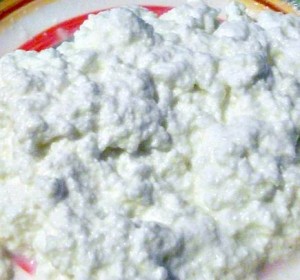By the author of Be Ready for Anything [2] and the online course Bloom Where You’re Planted [3]
Cottage cheese is one of those things that has far more ingredients than it should when you buy it at the store. Homemade cottage cheese is creamy, fluffy, and delicious, and it’s made with only 3 simple ingredients:
organic milk
white vinegar
salt
To compare, here are the ingredients of a common brand of cottage cheese sold at the grocery store:
Cultured Fat Free Milk, Buttermilk, Nonfat Dry Milk, Cream, Salt, Citric Acid, Lactic Acid, Phosphoric Acid, Natural Flavoring, Guar Gum, Mono and Diglycerides, Xanthan Gum, Carob Bean Gum, Titanium, Dioxide(artificial color), Maltodextrin, Cultured dextrose, Potassium Sorbate, Calcium Chloride, Enzymes
If you want to purchase organic cottage cheese, the ingredients will be better but the price will go up dramatically. But make it at home and the price is far lower. If your milk has just expired, but not turned totally funky, cottage cheese is a good way to use it up.
This recipe is for pasteurized milk from the store. If you are making cottage cheese with raw milk, go here to learn how [4] – the process is different.
Ingredients:
2-1/2 cups of 2% or whole milk
1/4 cup of white vinegar
dash of salt (optional – it’s just for flavor)
Tools:
Large heavy bottomed pot
Flour sack towel [6] (I use these in the kitchen constantly!)
Directions:
1.) In a large saucepan bring the milk almost to a boil. You want it to be a minimum of 185 degrees on an instant read thermometer like this one [5]. (It’s a small investment, but an important one for making homemade organic dairy products.) As soon as bubbles begin to rise to the top, remove the saucepan from the heat.
2.) Immediately stir in the white vinegar and the salt (if using). You will see the milk begin to curdle immediately.
3.) Allow the mixture to cool completely – about 1 hour at room temperature.
4.) Line a strainer with a flour sack towel [6], set it in a large bowl, and separate the curds and the whey (hints of Little Miss Muffet!) by pouring your curdled milk into the strainer. Keep the whey for other uses (discussed below).
The result will be a delicious, light and fluffy cottage cheese. I ended up with just short of 1 cup of cottage cheese and just over a cup and a half of whey. If your cottage cheese has a bitter taste, rinse the cheese under running water in the lined strainer and let it drain for another hour afterwards.
Some uses for whey:
- Substitute for water or milk in baking
- Use in place of part or all of the water when cooking rice or pasta
- Use it for smoothies
- Use it in oatmeal or other porridge
- Feed it to livestock for some yummy probiotics – dogs and chickens love it
- Make ricotta cheese
- Use it for lacto-fermentation [8]
Have you made cottage cheese?
Do you make your own cottage cheese? Does your recipe differ from this one? Let us know in the comments.
